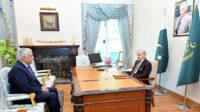Known as the City of Saints, this city of Multan in the Punjab province of Pakistan is full of shrines, ancient gates, shopping malls, gardens and parks.
Multan is one of the ancient historical cities which is mentioned in the time of Indraprastha and it is mentioned in ancient Hindu families as “Mali Than”. Meanwhile, there is also in the history books that a nation named “Mali Than” came and settled here and settling in Sanskrit is called “Sthan”.
Initially, its name was changed to “Mali Isthan”, later it was changed to “Mali Than”. Over time, “Mali Isthan” became “Mooltan” and now it became “Multan”. It is one of the oldest cities in the world and is the fifth largest city in Pakistan in terms of population.
Owner of Public News, Abdul Jabbar, fails to fulfil financial obligations
For those who are planning to visit this city, which is famous for its mango production and the famous souvenir Sohan Halwa, Baaghi TV presents a brief introduction of 10 significant places to visit.
1. Nigar Khana — A historical house of handicrafts
Nigar Khana, just opposite the mausoleum of saint Shah-Rukn-i-Alam, is a place in Qila Kohna Qasim Bagh. The gallery is adorned with colorful art pieces, paintings, wood and glass art pieces, handmade jewelry, animal skin art pieces and many more eye-catching items.

It is the center of attention for locals and tourists from outside Multan. It has been believed that actually the place was used as ammunition and it is last of its kind still survived in Fort Kohna, but now some exclusive Multani crafts and artistic stuff placed here are nice to see.

2. Shrine of Shah Rukn-i-Alam
The shrine of the famous Sufi saint Hazrat Shah Rukn-ud-Din Alam was built in 1324. The mausoleum is a collection of three Islamic cultures, Arabic, Iranian and Multani. This masterpiece of historical architecture, which is seven centuries old and one of the tallest tombs in the subcontinent, has also been inscribed on the UNESCO World Heritage List.

3. Clock Tower (Ghanta Ghar), Multan
The building was built in 1884 during the British Raj. In the form of a minaret, a clock is installed in this building which can be heard and seen from all sides. In the name of this cultural heritage, an area in Multan was named Ghanta Ghar Chowk which is located in the middle of the city.
The purpose of these clock towers, built during the British rule, was to highlight the importance of time to the people, but also to show the architectural passion and constructive innovation of the ruling elites of that era.

4. Mausoleum of Hazrat Bahauddin Zakariya
The Shrine of Bahauddin Zakariya Suhrawardi, a great preacher of Islam, is a 13th-century shrine located in the city of Multan, in Pakistan’s Punjab province. He passed away in 661 AH and people, tourists and pilgrims from all over the world visit his tomb. The architecture of the shrine is simply remarkable as the brick shrine is decorated with blue tiles and large wooden entrances.

5. Fort Kohna
“Fort Multan” also known as “Fort Kohna” is located in the heart of Multan and is a very old piece of architecture that was built approximately 2600 years ago. Almost 7,000 feet long and 40 feet wide, the famous Qasim Bagh and the stadium are also located inside the fort. The building was built for the cities of Multan to ward off invaders from western and northern neighboring cities. The fort is worth a visit due to its unique architecture as well as defense mechanisms. The highest wall of the fort also provides tourists with a view of the whole of Multan.

6. Van Alexander Agnew Monument
This monument was erected by the British East India Company (EIC) in honor of Patrick Alexander Vans Agnew (1822-48). The monument is to the memory of one of the sharpest political agents of the EIC whose killing in 1848 led to the siege of Multan and eventually inspired the British to thrust war on Sikhs that led to annexation of the Sikh Kingdom.

7. Haram Gate, Multan
The Haram Gate, one of the six historic gates of Multan, has recently been restored to its historic status, which had become obsolete with the passage of time. There was a time when Multan was inhabited by a huge river and it had many entrances. The invaders destroyed the gates as well as the city, then over time the city and the gates were rebuilt, one of them now in its original form is the “Haram Gate”.

8. Shahi Eid Gah Mosque
Built in the 18th century during the reign of Mughal King Muhammad Shah, this mosque is a masterpiece of Islamic and Mughal architecture located on Khanewal Road, Multan.

Furthermore, the mosque has seven domes, of which the middle dome is the most prominent and tallest. In Multan, the first call to prayer was given on the loudspeaker in this mosque and this mosque has the honor of having the largest gathering on the occasion of Eid.

9. Shrine of Shams-ud-Din Sabzwari
Shams-ud-Din Muhammad Sabzwari, one of the oldest saints of Multan, was a famous Sufi preacher. The tomb of Shamsuddin Sabzwari Multani is located half a mile east of Multan Fort. Shamsuddin Sabzwari died in 1278 and the shrine was built by his grandson in 1330. The shrine is square in shape, 30 feet (9.1 m) high and has a magnificent round dome. Moreover, it is decorated with green tiles and people from far and wide come to visit his shrine.

10. Shah Ali Akbar Tomb
Resembling the tomb of Shah Rukn-i-Alam in Fort Kohna but much smaller in size, the Mausoleum of Shah Ali Akbar is located in Suraj Miani Multan, in Punjab province, Pakistan. However, a foundation stone on the tomb provides its date of construction as 1585, indicating that Ali Akbar’s ministry flourished in the mid-16th century. He was the great-great-grandson of Shams-ud-Din Muhammad Sabzwari.

Stay tuned to Baaghi TV for latest news, updates and exciting content!






